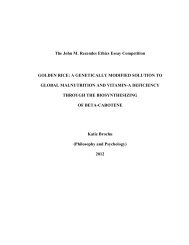MINERVA - Honors College - University of Maine
MINERVA - Honors College - University of Maine
MINERVA - Honors College - University of Maine
You also want an ePaper? Increase the reach of your titles
YUMPU automatically turns print PDFs into web optimized ePapers that Google loves.
P R O F I L E S<br />
■ ■ ■ ■ ■ ■ ■ ■ ■ ■ ■ ■ ■ ■ ■ ■ ■ ■ ■ ■ ■ ■ ■ ■ ■ ■ ■ ■ ■ ■ ■ ■ ■ ■ ■ ■ ■ ■ ■ ■ ■ ■ ■ ■ ■ ■ ■ ■ ■ ■ ■ ■ ■ ■ ■ ■<br />
maritime resources. Flash floods devastated the irrigation<br />
networks and homes. There were severe droughts<br />
in between many <strong>of</strong> the El Niño events were osevere<br />
droughts that also frequently reduced agricultural production<br />
and disrupted to the lives <strong>of</strong> the Moche people. The<br />
combination <strong>of</strong> El Niño floods and periodic droughts<br />
led to massive deposits <strong>of</strong> sand sheets one agricultural<br />
fields and habitation areas. The Moche State attempted to<br />
stem the destruction by moving the position <strong>of</strong> their sites<br />
up the main valleys where the detrimental effects were<br />
less significant. The Iconography <strong>of</strong> the Moche changed<br />
during this time in response to the disruption experienced<br />
in the lives <strong>of</strong> the people. Human sacrifices increased<br />
dramatically during this time <strong>of</strong> hardship in vain attempts<br />
to appease the angry gods. Political leaders may well have<br />
scrambled to divine the source <strong>of</strong> displeasure/disruption<br />
as sacrifices to appease them increased and other symbology<br />
and styles from neighboring areas began to show up<br />
in Moche sites. New emphasis was placed on trading in<br />
order to procure goods and sacrifices. The radical cultural,<br />
social, religious and political changes that took place<br />
during the fifth and final phase <strong>of</strong> the Moche State demonstrate<br />
how cultures can try to adapt to extreme environmental<br />
hardships.<br />
FUTURE PLANS: Graduate school at Michigan State<br />
NATHAN FRANK WEBB<br />
Manchester, <strong>Maine</strong><br />
Maranacook Community School<br />
MAJOR: Wildlife Ecology<br />
ACTIVITIES AT UMAINE: Student Chapter <strong>of</strong> The Wildlife<br />
Society; Xi Sigma Pi Honor Society<br />
THESIS TITLE: Characteristics <strong>of</strong> Hardwood Stands Used<br />
by Black Bears in <strong>Maine</strong><br />
ADVISOR: Frederick A. Servello<br />
THESIS DESCRIPTION: Long-term research by the <strong>Maine</strong><br />
Department <strong>of</strong> Inland Fisheries and Wildlife suggests that<br />
beechnuts are important to bear productivity in northern<br />
<strong>Maine</strong>. This research has indicated high use <strong>of</strong> hardwood<br />
stands by bears and it is suspected that this habitat use<br />
pattern is linked to the occurrence <strong>of</strong> American Beech.<br />
My objective was to investigate the relationships between<br />
forest structure and habitat use by bears. I measured overstory<br />
composition, the abundance and size <strong>of</strong> beech trees,<br />
and understory structure in 15 hardwood stands with<br />
high levels <strong>of</strong> documented use by bears and 15 hardwood<br />
stands with little documented use. I used a student’s ttest<br />
and nested ANOVA on ranks to test for differences<br />
between high and low use hardwood stands for 71 habitat<br />
variables. Variables with p




